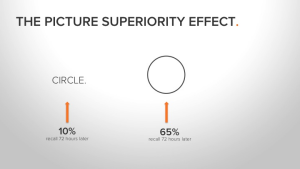Google CEO Sundar Pichai recently announced at the company’s 2017 developers conference that Google is “rethinking all our products” as it moves from a mobile-first world to an “A.I.-first” one. His presentation also reflected a rethinking of traditional presentation style. So where is this coming from?
The University of Washington biologist John Medina has done extensive research into persuasion and how the brain processes information. His advice is to burn most PowerPoint decks and start over with fewer words and more pictures. According to his book, Brain Rules:
“We are incredible at remembering pictures. Hear a piece of information, and three days later you’ll remember 10% of it. Add a picture and you’ll remember 65%.”
If you want to create visually interesting slides, less is more. Slide design guru Nancy Duarte recommends following a three-second rule. If viewers do not understand the gist of your slide in three seconds, it’s too complicated. “Think of your slides as billboards,” says Duarte. “When people drive, they only briefly take their eyes off their main focus, which is the road, to process a billboard of information. Similarly, your audience should focus intently on what you’re saying, looking only briefly at your slides when you display them.”
So how it does precisely works?
How can we remember facts better?
Or how do you keep YOUR presentation on top of your audience mind?
FACT: To better remember facts, combine visuals with information. Our visual sense is the strongest.

In an experiment, participants were shown 2,500 images for about 10 seconds each. Several days later, participants could recall the images with an impressive 90 percent accuracy. After a year, accuracy rates were still high, around 63 percent.
Yet when people listen to information, they only recall about 10 percent of it after a period of three days. Yet if an image accompanies spoken information, people will remember 65 percent of the information after the same period. This is called the pictorial superiority effect, an effect that scientists identified more than 100 years ago. The pictorial superiority effect says that our visual sense has a much stronger influence on our perception than any other sense.
To sum it up:
- Deliver information in a meaningful way so people remember.
- If you’re giving a lecture, keep it short so people aren’t overloaded. Also, give them the opportunity to take in the information with more than one sense: don’t just talk, but add visuals or sound to your presentation.
Let’s create our own memorable billboards presentations! Another nice article to read is the following. Which will share more tips & tricks from famous public speakers.
Love, Marietta


